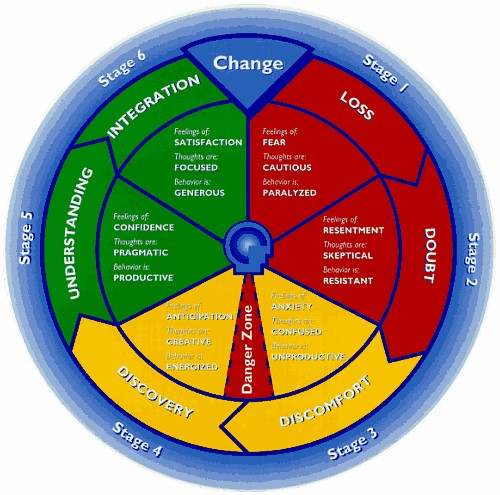How to deal with change management effectively

Just the word “change” can result in unease and stress yet, much like death and taxes, change is inevitable and unavoidable. Within business, it is a vital element to allow growth and indeed survival during tough times. Yet we still fight against it.
The Change Cycle® Model illustrates the six predictive stages of reaction to change: Loss, Doubt, Discomfort, Discovery, Understanding, and Integration. Within each of those reactive stages, the Model identifies the feelings, thoughts and behaviour that take place, illustrated with a traffic light system.

Effective Change Management will lead the organisation through the Cycle quickly and efficiently with minimum negative impact. With the correct training, processes and culture, time in Stage 1 to 3 can be minimised, with energy and focus taking place in Discovery, Understanding and Integration.
To be able to do this there needs to be an understanding of why people resist change. Three reasons we have frequently encountered are:
Us and Them
The attitude that any decision made by “management”, must result in a detrimental effect on the workforce. The response of … “Well, they tried that back in 1983 and it didn’t work then either”. Whilst the response may be motivated by other fears, it is likely to be embedded within the culture of the organisation and whether the change is to stop buying biscuits for the tea room, or to restructure the division, the reaction is likely to be the same.
Fear of Personal Impact
The fear that status, security, pay, routine, the general status quo for them as an individual will alter, can mean resistance. This group are not interested in the bigger picture, and in the extreme it can result in a feeling of persecution and paranoia. Often encouraged by a lack of information and understanding why it is happening, and what exactly is happening.
Unwillingness to Learn
People may be unwilling to learn a new skill or a new way of working. Often seen in manufacturing “shop floor” environments where an employee may be skilled and experienced in one way of working but is unwilling to learn a new technical skill, or approach. This can be linked to the fear of personal impact and concern that their status as an expert may be lost.
The list can go on – fear and resistance to change due to habits, loss of control, disagreement the change should happen.
The key element in change management is to ensure change is accepted. The level of acceptance can be increased through 4 simple steps:
- Be clear on why, and communicate the rationale in such a way that people understand
- Involve people in the decision-making process
- Have a robust change management system in place so there is a history of successful change management
- Have planned changes rather than reactive changes.
Here’s how to achieve those four steps:
Leadership
Change needs a strong leader and buy-in to the process needs to be unanimous from the top. Successful change is team-led not individual led.
Create a team of experts to deliver the change programme:
- Senior Leaders with the skills to drive and manage the process
- Employees, as experts in the area being affected by the change
- Implementation experts to pull the process together and with the credentials to show previous success at implementing change.
This team need to model the behaviour you are seeking from others – to lead by example – and to have the skills and knowledge to not only to lead change but to also demonstrate they have the technical understanding and industry knowledge.
Communication
Effective Communication is at the centre of Change Management. Communicating after the change delivery has commenced will heighten employee’s fears, increase the feeling of us and them, and lower trust. Brief people who will be impacted by the change before any real change is delivered. Include identifying risks and potential problems. By sharing concerns it will pull the organisation together, allowing the team to discuss and help find the solutions.
By having employees on the change leadership team and through wider briefings at an early stage, employees can become change agents.
Training and skills development during a period of change can lay rest to fears and improve understanding, therefore acceptance of the change. Showing your employees that you value them and want to retain them during a challenging period will result in a culture of a team approach. By being clear why they are attending the training, or being asked to improve skills, will remove any suspicion, encourage buy-in and increase the value of the learning experience.
Human Resources
HR is a vital component of successful change implementation. Business cases can often focus on cash flow and capital expenditure, overlooking the effect and cost on human capital.
The Change Leadership team must have a representative from HR. And not just any representative: one with character, a strong leader themselves, one who is not afraid to ask difficult questions, one who has the trust of the workforce based on experience and reputation. HR cannot join this process as a tick in the box, or an after-thought when the organisation realises they are hitting resistance. There is a role to ensure legalities are covered and processes are followed, but the HR input needs to be far greater than that.
HR must be continually driving long term succession planning, recruitment programmes, skill-gap identification. Not only are HR there to work with the Change team and leader, but also to ensure that the resources are available to make certain the Change is a success and can actually materialise. It is here that HR can really make a difference.
By ensuring that Leadership, Communication and HR are in place driving the change, and working with employees from an early stage, Change Management can be effectively managed. Resistance can be anticipated and dealt with, fears can be aligned and a culture of successful change management can be developed and embraced.
Please do get in touch on 01473 360160 if you are facing a period of change to find out how Make A Difference HR can provide you with the expert HR leader input that will support your team and drive your change programme forward.
“Support when You most Need It”
“Always at the end of the phone or easy to email and have answers returned quickly when a situation calls for a quick response” Read the full review



